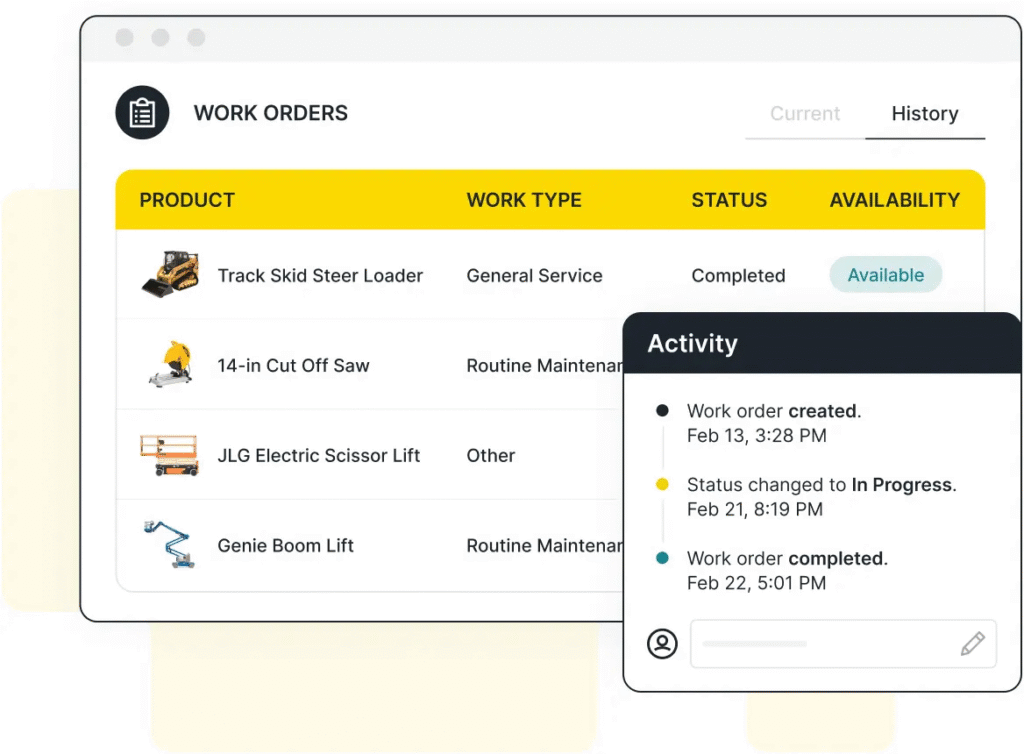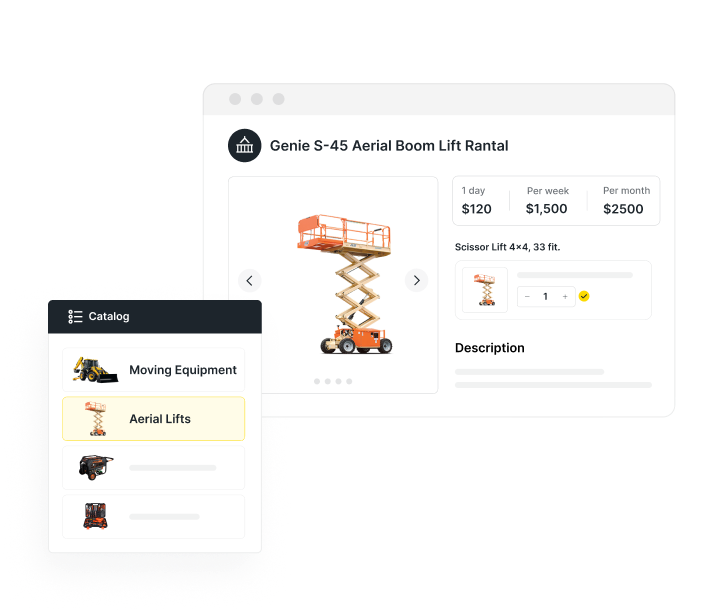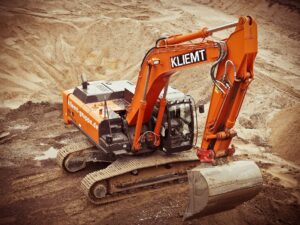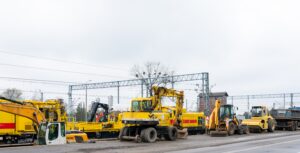When it comes to planning for equipment damage, being proactive can save you time, money, and headaches down the line. And, it’s an essential part of proper equipment rental inventory management.
This article will guide you through practical steps to prepare for equipment damage and maximize your rental equipment’s lifetime so you stay ahead of the competition and provide exceptional service to your customers.
Table of Contents
- Equipment Damage Is Inevitable, So It’s Essential To Plan Ahead
- Handling Incoming Rental Damages
- Putting Equipment Damage Protections in Place
- Stock Up on Commonly Needed Replacement Parts
- Implement a Well-Defined Damage Waiver Policy
- Find a Good Service Manager
- Quipli Makes Work Order Management Easy
- Frequently Asked Questions
Equipment Damage Is Inevitable, So It’s Essential To Plan Ahead
No matter how well you maintain your equipment, it will eventually need repairs. Whether you’re renting out heavy construction machinery or smaller tools, wear and tear is part of the business. By being aware of the possibilities of damage, ensuring your equipment is insured, implementing a solid damage waiver policy, and stocking replacement parts ahead of time, you can be prepared to address and repair damage to your machinery promptly.
Breaking free from rental gridlock means having systems in place before damage occurs. This proactive approach transforms what could be a major operational bottleneck into a manageable part of your rental workflow.
Handling Incoming Rental Damages
When equipment returns damaged, your response in the first few hours can make the difference between a minor hiccup and a major dispute. Here’s your step-by-step process for managing the situation effectively.
Review for Normal Wear & Tear
Not all equipment changes constitute damage. Understanding the difference between normal wear and actual damage is critical for maintaining customer relationships while protecting your assets.
Normal wear includes minor scratches on painted surfaces, slight tire wear on construction equipment, or dust accumulation. Actual damage involves bent components, cracked housings, hydraulic leaks, or any condition that affects the equipment’s safe operation. Train your team to recognize these distinctions to avoid unnecessary customer conflicts.
Documentation
Thorough documentation protects both your business and provides transparency for customers. The moment damaged equipment arrives, begin your documentation process.
Photo Documentation: Always take high-quality photos from multiple angles, capturing both the specific damage and the overall equipment condition. Create a written report detailing the damage location, severity, and potential impact on equipment operation. Compare these findings with your pre-rental documentation to establish a clear timeline of when damage occurred.
Document Storage: Store this documentation in a centralized system where it can be easily accessed for customer communications, insurance claims, or internal maintenance planning. Digital documentation through your rental management system ensures nothing gets lost and creates an audit trail for every piece of equipment.
Review the Damages Clause & Waiver Forms
Before contacting the customer, review your rental agreement’s damage clause and any waiver forms they signed. This review ensures you’re on solid ground and helps you communicate clearly about their responsibilities.
Check whether the customer purchased a damage waiver and what it covers. Verify the agreement’s language about damage responsibility and billing procedures. Note any special circumstances or exceptions that might apply to this specific rental. This preparation helps you approach the conversation professionally and with confidence. The last thing you want on your hands is a nasty lawsuit.
Customer Communications
Timely, professional communication sets the tone for damage resolution. Contact the customer within 24 hours of discovering damage to maintain transparency and trust.
Start the conversation by stating facts without accusations. Present your documentation clearly and reference the specific rental agreement terms. Discuss repair timelines and costs openly, and if applicable, explain how their damage waiver applies. For significant damage, consider scheduling a call rather than relying on email to ensure clear understanding on both sides.
Getting Equipment Fixed
Once damage is documented and communicated, focus on getting equipment back to rental-ready condition quickly. Rental gridlock often happens when damaged equipment sits idle waiting for decisions or parts.
Assess whether repairs can be handled in-house or require outside service. For equipment under warranty, contact the manufacturer immediately to understand coverage. Create a work order in your system to track repair progress and associated costs. If the repair will take extended time, update your availability calendar to prevent double-booking.
Pro Tip: If you’re looking to handle this with a few clicks, Quipli can effortlessly handle your service and repair management, all in one central place. Check out the maintenance and repair features.
Putting Equipment Damage Protections in Place
Proactive protection strategies minimize the financial impact when damage inevitably occurs. Building these safeguards into your operation creates a more resilient, high-velocity rental business.
Rental Equipment Insurance Coverage Can Help You Cover Repair or Replacement Costs
Make sure you have adequate coverage for the relevant types of insurance for the equipment that you rent out to customers. Comprehensive rental equipment insurance can cover repair or replacement costs in the event of damage, theft, or other unexpected incidents.
When selecting insurance coverage for your rental equipment, it’s essential to consider factors such as the types of equipment you rent out, the risks associated with their use, and the potential financial impact of various incidents. Work with an experienced insurance agent to develop a customized insurance plan that addresses your specific needs and concerns.
Having the right insurance in place not only provides financial protection but also gives you peace of mind, allowing you to focus on running your business effectively. Furthermore, it demonstrates professionalism and responsibility to your customers, fostering trust and a positive reputation within the industry.
Types of Insurance Coverage for Heavy Equipment
- Commercial Auto Insurance: Applicable to many types of motor vehicles, including some kinds of heavy construction equipment. This type of insurance provides coverage for physical damage, liability, and other expenses related to an accident or damage involving a vehicle.
- General Liability Insurance: Protects your company’s assets in the event of a lawsuit. It covers property damage, personal injury, and other liabilities arising from your business operations.
- Inland Marine Insurance: A type of property damage insurance that covers certain items or contingencies that other kinds of insurance may not. It can cover equipment during transportation, at job sites, or in storage.
- Property Insurance: This can apply to a wide variety of different equipment your company owns and uses. Highly customizable, can cover situations like employee damage or theft. This insurance covers damage to your property due to events like fire, theft, vandalism, and natural disasters.
- Worker’s Compensation: Protects your employees and helps ensure that you’re able to cover workman’s comp in the event of a workplace accident. It provides medical benefits and wage replacement for employees injured on the job.
- Umbrella and Excess Liability Coverage: An addition to standard liability insurance that can help expand the amount of coverage you’re able to get. It provides additional protection when the limits of your underlying policies have been exhausted.
- Loss of Use Insurance: Can help you recover some of the lost revenue if equipment is out of commission for repairs due to damage. It compensates you for the income you would have earned if the equipment had been operational.
- Property in Transit Insurance: Covers damage to equipment during shipment or transit. It provides protection for your equipment while it is being transported between locations or job sites.
- Replacement Cost Coverage: Helps pay to replace a piece of equipment that was stolen, or was destroyed entirely and cannot be repaired. It covers the full cost of replacing the equipment with a new, similar item without factoring in depreciation.
Stock Up on Commonly Needed Replacement Parts
Supply chain disruptions have taught the rental industry a valuable lesson about parts availability. Even now, lingering supply chain issues can turn a simple repair into weeks of lost rental revenue.
Planning ahead and keeping replacement parts available ahead of time can help you ensure timely repairs on equipment, getting them back on rent and generating revenue faster. Multi-month wait times for a critical machinery part could mean significant lost revenue on that piece of equipment.
To avoid this situation, establish relationships with multiple reliable suppliers and manufacturers. Maintain an inventory of commonly needed replacement parts, such as filters, belts, hoses, hydraulic fittings, and electrical components. Track your repair history to identify which parts you use most frequently and adjust your inventory accordingly.
Consider creating a parts matrix that categorizes items by criticality and lead time. Stock more of the parts that frequently fail and have long lead times. This proactive approach minimizes downtime and ensures that your equipment remains in top condition.
Implement a Well-Defined Damage Waiver Policy
A damage waiver on rental equipment clarifies the customer’s responsibility for any damage caused to your equipment. Being clear and upfront about the customer’s responsibility and your method of collecting damages if necessary will help protect your company while providing value to customers who want protection.
Understanding Damage Waiver Best Practices
Industry experts share valuable insights on implementing effective damage waiver programs that protect both rental companies and their customers.
A well-defined damage waiver policy should include the following elements:
- Clear definitions of the types of damage covered by the waiver
- Explanation of the customer’s financial responsibility for damages
- Procedures for reporting and documenting equipment damage
- Timeline for returning damaged equipment and initiating repairs
- Specific exclusions (negligence, theft, mysterious disappearance)
Providing customers with a comprehensive damage waiver policy will not only protect your business but also help establish trust and transparency in your customer relationships. Many customers appreciate the option to limit their liability, making it a valuable revenue stream for your business. And industry experts advise on using insurance strategically, to mitigate your exposures.
Recommended Resource: Equipment Rental Liability Waivers: What to Include (With Free PDF Template)
Find a Good Service Manager and Put Strong Internal Processes in Place
Hiring a skilled and experienced service manager is crucial for companies that rent out heavy equipment and tools. Strong internal processes will keep damaged equipment moving smoothly through the maintenance and repair process and avoid booking out equipment that isn’t usable yet.
The service manager plays a vital role in optimizing equipment performance, reducing downtime, and maintaining a high level of customer satisfaction. Their expertise in handling equipment maintenance ensures that your rental fleet is always in top condition, ready to meet the needs of your clients.
A quality service manager should establish clear workflows for damage assessment, create realistic repair timelines, coordinate with parts suppliers and outside service providers, and maintain detailed service records for each piece of equipment. They should also train counter staff on equipment inspection procedures to catch damage early.
Quipli Makes It Easy To Create, Track, and Manage Work Orders
Breaking free from rental gridlock requires unified systems that give you complete visibility into your equipment status. Quipli’s service and repair features transform how rental businesses handle equipment damage and maintenance.


Quipli’s suite of service and repair features allows you to streamline communication between departments and improve overall efficiency. The platform helps you monitor equipment usage patterns, identify trends that may indicate potential issues, simplify the process of scheduling maintenance and repairs, and ensure that all necessary documentation is easily accessible and up-to-date.
Key features that accelerate your service operations:
- Real-Time Work Order Management: Track ongoing work orders with complete visibility into progress, parts used, and labor hours
- Equipment Status Tracking: Mark machines as “soft down” or “hard down” to prevent availability conflicts
- Comprehensive History: View detailed work order histories and machine hour breakdowns
- Customer Billing Integration: Link damage repairs directly to customer invoices for streamlined billing
- Parts Inventory Management: Track parts usage and maintain optimal stock levels
By incorporating Quipli’s unified platform into your rental equipment management process, you eliminate the silos between service, billing, and operations that create costly delays.
Frequently Asked Questions
What Does Equipment Rental Insurance Not Cover?
Equipment rental insurance typically excludes normal wear and tear, gradual deterioration, and damage from improper use or maintenance. Most policies won’t cover mysterious disappearance, employee theft, or damage resulting from violation of the rental agreement. Intentional damage, war, nuclear hazards, and certain natural disasters may also be excluded depending on your policy.
Should I Collect a Damage Deposit?
Yes, collecting a damage deposit provides financial protection and encourages responsible equipment use. Deposits create a psychological incentive for customers to care for equipment and provide immediate funds for minor repairs. However, balance this with customer experience—high deposits may deter rentals. Consider offering damage waivers as an alternative that provides protection while improving cash flow.
How Do I Handle Equipment Being Out of Service for Repairs?
First, update your availability immediately to prevent double-booking and customer disappointment. Communicate realistic timelines to affected customers and offer alternative equipment when possible.
Track downtime costs to make informed decisions about repair versus replacement. For extended repairs, consider rental reimbursement from your insurance or pursuing loss of use claims against responsible parties.
How Much of a Damage Deposit Should I Collect?
Damage deposits typically range from 10-25% of the equipment’s value or total rental cost, whichever is higher. Consider factors like equipment value, typical repair costs, customer history, and rental duration.
For high-value equipment, a percentage model works best, while flat fees may suit smaller tools. Always clearly communicate how deposits are held, when they’re returned, and what damages they cover.
Unlock Your Rental Equipment’s Full Potential
Don’t let equipment damage and downtime hinder your business’s success. Discover how Quipli’s equipment rental software can help you streamline your equipment management process, reduce downtime, and ensure your rental equipment remains in top working condition.










